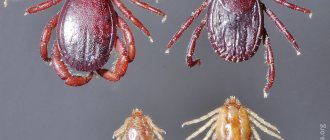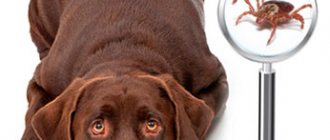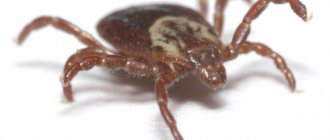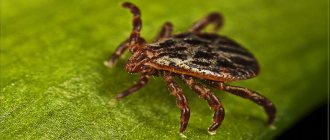Another common type of ectoparasite (external) is ticks in dogs. When people talk about ticks and how dangerous it is in the warm season, they mean one of the types of skin parasites – ixodid ticks (Ixodidae). In fact, several species of these arthropods parasitize dogs. Some of them gnaw the skin of animals, others suck blood, and for others, the lymph and skin secretions of your pet are a source of food. As a result of the activity of ticks, the animal may develop a severe allergic reaction, viral and bacterial diseases, as well as abscesses and dermatitis.
Where can a dog catch a tick?
The danger of infection with ixodid ticks appears in the warm season. Ticks become active in early spring and go into hibernation only in late autumn, when the first frosts occur. The most dangerous time is the end of May and the beginning of June. These carnivorous arthropods have special thermal sensors with which hungry parasites find prey.
Ticks sit on tall grass or bushes, waiting for prey. As soon as a dog passes by, the little parasite makes a jump, grabs the animal’s fur with its tenacious tentacles and begins to look for a place free of hair. When such a place is found, and this could be the groin area, parotid area, legs, stomach or neck, the tick pierces the skin and begins to suck blood.
Infection with other types of ticks occurs mainly through care items contaminated with parasite eggs: beds, bedding, dog toys. The second method of infection is contact.
Types of ticks
So, there are three types of ticks that parasitize dogs:
- Ixodes. The largest tick that feeds on the blood of animals.
- Subcutaneous mite (demodectic mite). It feeds on epithelial cells and blood.
- Scabies (internal, ear). Feeds on epidermal tissues.
Ixodid ticks
Parasites wait for their victims on the street: in the forest, on a dog-walking area, in the country, in public gardens and parks. Despite the painful symptom, ixodid tick bites themselves do not pose any particular danger. Much more dangerous than the diseases that a tick can infect a dog with.
Attached ixodid ticks are revealed by visual inspection of the animal's body - these are small brown bubbles with legs. If your dog's fur is very thick, you may not notice parasites right away. The situation is complicated by the fact that the tick can suck blood and fall off unnoticed.
Symptoms of a tick bite in a dog:
- weakness, the animal is lethargic, constantly lying down;
- thready pulse;
- loss of appetite;
- the whites of the eyes acquire a jaundiced tint;
- urine darkens: brown, brown;
- vomiting with bloody mucus;
- hyperthermia (40°-42°C);
- difficulty breathing, shortness of breath;
- swelling;
- lameness.
Dangerous diseases caused by tick bites
- Piroplasmosis (canine encephalitis). The encephalitis tick poses the greatest danger to young purebred animals. Without timely, properly selected treatment, the mortality rate from this disease can reach 100%.
- Lyme disease (borreliosis). A widespread disease with a long incubation period - up to 2 months. Detected by a laboratory blood test. Treatable if detected early.
- Ehrlichiosis. The incubation period is 7-20 days. The disease is common in tropical and subtropical regions. In progressive cases, death is possible.
Sometimes, after removing the tick, a reddened lump remains on the dog’s body. This is not a symptom of a dangerous disease, it is the result of an allergic reaction to chemicals in the bloodsucker's saliva. All you need to do is lubricate the seal with brilliant green and prevent the dog from scratching this area.
Dog lovers should know what to do if their dog is bitten by a tick. First, you need to properly remove the attached parasite at home or in a veterinary clinic. Secondly, submit the removed insect for analysis. Third, take the dog to a veterinarian for diagnosis and treatment.
Subcutaneous mites
The peculiarity of this type of parasite is that they live in the internal organs, hair follicles and sebaceous glands of any dog. If an animal has excellent health and strong immunity, its body independently controls the number of uninvited guests. But as soon as the animal’s body weakens and the immune system fails, the tick begins to multiply uncontrollably - this leads to the development of a disease such as demodicosis. Popularly, this pathology is often called red scabies or scabies.
The first signs of the disease:
- bald patches appear on the animal’s body;
- the skin in areas of bald patches becomes rough, peels, becomes covered with scales and thickens;
- pink or red rashes appear in areas without fur, sometimes with purulent contents;
- the dog experiences severe itching, constantly scratches, injuring itself;
- the hair changes its structure, becomes dull, brittle, and shaggy;
- in long-haired breeds, shortening of the guard hairs is possible;
- Dandruff may appear.
The main forms of demodicosis:
- Focal (localized). Dogs up to one year of age are susceptible. It is characterized by the appearance of several bald patches with rough, flaky skin. In the vast majority it goes away on its own. Only 10% of cases become generalized.
- Generalized. Bald patches gradually spread throughout the dog's body. Inflammation develops and the skin develops an unpleasant odor. Older individuals have a less favorable prognosis for full recovery.
- Juvenile. Hereditary disease. Puppies up to one year of age are susceptible. Favorable prognosis for cure.
- Pododemodicosis. A disease with a lesion on the paws. The weak point of cocker spaniels. Bald patches, boils, purulent inflammation, and erythema appear on all limbs.
- Otodemodecosis. Inflammation of the outer ear. Bald patches appear around the ear. Black crusts form in the ears. The dog is experiencing severe itching.
Regardless of its form, ironworm is considered a non-contagious disease. The main reason for the appearance of bald patches, itching and painful areas of the skin is weak immunity. To reduce the risk of this pathology, the dog owner must take care of improving the health of his pet.
Scabies mites
This group of parasites includes two types of mites: scabies (internal) and ear mites (cutaneous). These are microscopic arthropods that resemble crabs in appearance. Once on the dog's skin, the parasites begin to multiply very quickly. Tick colonies in advanced cases can number up to several thousand individuals.
Signs of scabies mite infestation:
- the dog experiences severe itching, because of this it constantly itches, shakes its head, scratches itself;
- Scabs appear in places where scratching occurs;
- Foci of redness and blisters with cloudy liquid appear on the ears, eyebrows, bridge of the nose, at the root of the tail, on the stomach, in the chest area and on the head;
- the skin in places of irritation becomes rough;
- the dog's hair changes its structure: it becomes dull, coarser, and a shaggy effect appears;
- in places of pathological foci, hair falls out intensively;
- dermatitis develops;
- the skin becomes rough, cracks, and an “elephantiasis” effect appears;
- large dandruff appears - particles of dead epidermis;
- the animal is worried, sleeps poorly;
- The dog loses its appetite and becomes exhausted.
The main question that worries dog owners is whether a dog can die from infection with scabies mites. The answer is disappointing - maybe, if treatment is not started in time. The death of the animal occurs from general exhaustion of the body.
Diseases caused by the scabies mite:
- Sarcoptic mange. Caused by itching of the genus Sarcoptes. Locations affected: head, abdominal area, root of the tail, sternum area.
- Notoedrosis. Invasive disease. The causative agent is the Notoedres mite. Location: dog’s head: forehead, brow ridges, nose. In advanced cases, it can spread to the limbs.
- Otodectosis. Ear scabies is a contagious disease. The causative agent is the small white tick Otodectes cynotis. Parasites are localized in the ear. The skin of the shells turns red, ulcerates, and becomes covered with dark crusts. It is characterized by severe itching. Without treatment, it can spread to the head and entire body. The danger of the disease is that inflammation can spread to the inner and middle ear, meninges. This provokes nervous attacks and can cause the death of the dog.
The clinical picture of scabies resembles other diseases: dermatitis, demodicosis, eczema of the auricle. Therefore, a final diagnosis can only be made within a veterinary clinic based on the results of laboratory tests.
How do Ixodid ticks attach themselves to a dog?
The tick climbs onto grass stems, bush branches, or simply waits in the grass litter. As a rule, it does not crawl above one meter from the surface. The insect reacts to the appearance of the victim not only visually, but also by vibration, smell, and approaching heat. If the attack and attachment fail, hungry ixodid ticks can live for at least 3 years (studies have shown that up to 14).
As soon as the ixodid has found the right owner, it begins to choose secluded places for feeding - they love to suck on the head area, in the groin, under the paws.
This bloodsucker bites through the skin with the help of chelicerae and inserts a jagged hypostome (in the shape of an anchor) - part of the oral apparatus - into the wound. This is precisely what explains the particular difficulties in extracting the insect from the skin. ixodid ticks bite , they secrete saliva containing vasodilating and anticoagulant substances.
This gives an analgesic effect. The animal does not feel anything when bitten. The parasite can remain unnoticed and continue feeding calmly. Feeding lasts 4-6 days, on the first day blood is absorbed minimally, then gradually increasing. During this time, the female increases almost 100 times from its original size. Males don't require that much blood.
How to remove a tick from a dog
A tick removed in a timely manner is a chance that the animal did not have time to become infected with anything. All parasites found on the dog's body must be removed. This must be done by adhering to the following rules:
- If a tick has attached itself to your pet, forget about the common advice - do not use vegetable oil or gasoline to pre-treat the insect. This will kill the bloodsucker, but at the moment of death he will release the contents of his stomach into the dog’s blood - dangerous infections will occur.
- All you need to remove is tweezers and rubbing alcohol. The body of the parasite and the place where it has attached itself to the skin are moistened with alcohol or its analogue.
- When the alcohol takes effect and the dog’s tick slightly relaxes its proboscis, begin to remove it.
- The parasite is grabbed with tweezers and slowly and carefully twisted counterclockwise. The tweezers should be held parallel to the skin or at a slight angle so as not to damage the bloodsucker's body.
- If the head of the tick remains inside the dog's skin, it is necessary to immediately show the animal to a veterinarian.
After removing the insect, it is submitted for analysis, and the pet is closely monitored in order to notice in time changes in the dog’s behavior after the bite and a possible deterioration in its condition.
Important! Remember that many dangerous diseases transmitted through parasite saliva have a long incubation period.
How to remove a white tick from a dog?
If you find a tick on a dog, it must be removed, regardless of the color of the parasite, its size and other characteristics. If the extracted parasite seems too strange to you, it is better to submit it to the laboratory. Ticks that are not typical for a particular area can be imported from tourists or animals that have been at exhibitions in other regions.
It is important to understand that almost all ticks can carry a number of diseases, and rare varieties of parasites are much more dangerous.
How to remove a white tick from a dog? Most likely, the white parasite you found is a pasture tick that has already fed on blood and become bloated. At this stage, the parasite does not hold onto the skin too tightly.
Prepare:
- A special product, oil, cream, Vaseline, nail polish - for coating the tick.
- A strong thread, a special hook or tweezers with a flat grip - for twisting the tick.
- Antiseptic for treating wounds, but not iodine or brilliant green.
- A small jar to take the tick to the laboratory or destroy it in oil.
Ticks have come a long way in evolution, but they have weaknesses. The parasite breathes through its body, so it can be forced to remove its paws and head from the dog's skin. To safely and practically painlessly remove a tick, it is enough to create a dense film that does not allow oxygen to pass through. Experiencing oxygen starvation, the parasite will remove its paws from the skin, freeing up space between the abdomen and the dog’s skin.
With each new layer of a product that does not allow air to pass through, the tick will weaken its grip. You will notice that the parasite has become mobile and scrolls along the skin (around its axis) almost 180 degrees when it removes all its paws from the skin. In total, the process can take from 15 to 40 minutes.
If you use a special hook, you just need to pry the tick and turn it out of the skin. When using tweezers, you need to act carefully so as not to crush the shell. A loop is formed from the thread, which is tightened around the tick's head and twisted into a flagellum.
Regardless of the product you use, the moment the head is removed from the skin, the dog will feel a stabbing pain. It is very important to keep your pet still, so it is best to enlist the help of a friend or family member. Sudden movements at this stage will lead to the head being torn off, which will remain in the skin.
If the procedure is successful and the tick is completely removed, the bite site is treated with an antiseptic. The dog's condition is closely monitored for 2-3 days after the tick is removed, since it is during this period that the first symptoms of piroplasmosis may appear.
Diagnostics
Diagnostic measures begin with collecting anamnesis and differ depending on the type of ectoparasite. Ixodid ticks can be identified by visually inspecting the animal's body after each trip outside. The found parasite is carefully removed and sent for analysis to a veterinary clinic. Blood is taken from the dog to make a diagnosis.
If the bloodsucker is not found, monitoring the condition and behavior of the dog helps in making a diagnosis. When the first symptoms of the suspected disease appear, an urgent visit to the veterinarian is necessary for laboratory tests.
The clinical manifestations of infection with subcutaneous and scabies mites are very similar, so the diagnosis is made only after laboratory tests of superficial and deep skin scrapings. Scrapings are made in a medical facility using sterile sharp cutting objects in places where the pathology is localized. After this, microscopic examinations are carried out to identify parasites, their larvae and eggs. Depending on the type of mites detected, further treatment is prescribed.
Anti-tick medications for dogs
Since dogs are susceptible to infection by three types of ticks, veterinary medicine uses targeted drugs that are active against one type of parasite. In addition, the pet industry produces products to prevent infection.
Medications are available in several forms:
- ointments;
- aqueous emulsions;
- liniments;
- pills;
- oil solutions;
- drops;
- injections;
- shampoos;
- aerosols and aerosol foams.
Preventive measures:
- tick collar;
- drops on the withers;
- anti-tick spray.
Effective treatments for ticks
In modern veterinary medicine, to get rid of tick-borne infestations, the following are used:
- Sulfur-tar ointment (AVZ). An effective domestic cure for scabies.
- Dectomax (USA). Injection for the treatment of demodicosis (subcutaneous mite).
- Delcid (AVZ). Therapeutic and prophylactic emulsion against tick infestation.
- Bravecto (MSD Animal Health). Anti-tick tablets.
- Vio (Beaphar). Drops on the withers against fleas and ticks.
- Lawyer (Bayer). Drops against scabies mites.
- Tropiclean "Maximum protection". Anti-tick shampoo.
- Stronghold. The best drops against ear and scabies mites.
- Yam BK (AVZ). Ointment against scabies and dermatitis.
- Ivermek. Injectable drug against sarcoptic mites.
- Frontline (Merial). Tablets for killing ticks.
The following are used as protective and preventive agents:
- Bars (AVZ). Spray with insectoacaricidal effect.
- Foresto (Bayer). Anti-tick and flea collar.
- Mr Bruno. Spray against ixodid ticks.
- Rolf Club. Anti-parasite spray.
- Inspector. Therapeutic and prophylactic drops.
- Anti-mite. Ultrasonic repeller.
How to use medications correctly
We described how to properly remove ixodid ticks just above in this article. Let's talk about how to properly organize treatment for a dog in cases of infection with subcutaneous and scabies mites.
The first thing a dog owner should do after an accurate diagnosis has been established is to isolate the animal from other pets. After this, the sick animal must be thoroughly washed with tar soap. This is necessary in order to cleanse the dog's skin of scabs, dandruff, oil and dirt.
At the end of bathing, to enhance the effect and reduce itching, the animal is rinsed with decoctions of medicinal herbs: chamomile, string or celandine. After water procedures, the dog is thoroughly dried with a dry cloth and kept in a heated room until the fur is completely dry.
The fur in areas affected by ticks is shaved. Wounds and scratches on the skin are treated with antimicrobial ointments. To do this, you can use drugs from the owner's first aid kit: Vishnevsky ointment or Konkov suspension.
After this, the mite-infested areas of the skin are treated with medications prescribed by the veterinarian. The doctor selects an individual treatment regimen for each dog, taking into account its age, breed, health status and existing chronic diseases. It is unacceptable to treat a dog without an accurate diagnosis, selecting medications yourself. Rehabilitation of an animal after an ixodid tick bite should also be carried out under the supervision of a veterinarian .
Types of ticks in dogs and symptoms of their bites
The risk of finding a tick on a dog increases with the onset of spring. When it gets warmer and the temperature rises above zero degrees, small insects begin to hunt. In summer, at the peak of the heat, ticks are less active, but even then the likelihood of a bite is considerable. Ixodid arthropods move slowly and do not jump from trees, as many mistakenly believe, but they have the ability to feel the warmth of a mammal ten meters away. After the tick senses food, it begins to crawl towards the animal. Having reached the target, it moves onto the dog's fur.
Some time after the tick has landed on the dog, it explores the area in search of thin skin: there it will be easier for it to obtain the necessary nutrients from the blood. As a rule, their “favorite” places are the neck, ears, and stomach, but they can also cling to the back and other places. In some cases, the tick's search for suitable feeding conditions takes several hours, which gives the dog owner the opportunity to detect it in time. They are attached for a long time (see the image below), and the first watch will not be too difficult to remove.
Once the tick has firmly embedded itself into the dog’s skin, it no longer changes position. The feeding period is several days. Due to a special natural anesthetic that is injected into the blood at the site of the bite, the dog cannot feel the foreign body at first and does not experience discomfort - itching and irritation appear only on the second or third day. If a tick has infected a dog with something, unpleasant symptoms occur earlier.
Ear mite
An ear mite is a common ixodid insect that gets into a dog's ears and bites him there. When it gets inside the ear, the dog begins to feel discomfort almost immediately. The first symptom of an ear mite is permanent itching, forcing the pet to scratch the affected area, often injuring itself. Then a second obvious sign appears: a brown liquid with an unpleasant odor that comes out of the ear. Upon seeing this symptom, the owner should immediately contact a veterinarian who will prescribe anti-tick medications.
Subcutaneous mite
The subcutaneous mite infects the inner layer of the epidermis, sebaceous glands or hair follicles of the dog. When bitten, harm is caused not only to the skin, but also to internal organs. Signs of a tick bite: severe itching, causing the dog to constantly scratch, baldness in the affected areas, the appearance of small wounds and ulcers. Basically, subcutaneous mites infect puppies whose immunity is still weak, usually entering the body from the mother. It is difficult to treat the affected skin areas, so it is better to protect your pets in advance.
Folk remedies for ticks
Folk remedies have no proven effectiveness; they are used for mild forms of the disease and in the initial stages to alleviate the pet’s condition.
- Garlic. Garlic cloves are crushed and poured with almond oil (1:2). After this, they are placed in a dark place for 3-4 days. The resulting tincture is applied to the affected areas.
- Sulfuric ointment. Helps with scabies.
- Black sulfur. Used as part of kefir tincture (1:3).
- Lavender oil. Apply to the skin. When the oil is absorbed, rub the affected areas with chalk powder.
- Vanillin. Vanillin is infused in water or vodka, and the dog’s fur is treated with this solution before going outside.
You should not abuse any of these products - they act very aggressively on the dog’s skin: they cause burning, dry it out, provoke allergic reactions and other negative consequences.
As a preventive measure against ixodid tick bites, the following are used in folk medicine:
- Essential oils. The pet's fur is rubbed with oils: lavender or tea tree.
- Tar soap. Use it while bathing - it is an excellent therapeutic and prophylactic remedy.
- Sagebrush. Spray your dog with a water tincture of wormwood.
You can prepare a remedy for ticks at home from an aqueous solution of tar soap, myrrh, tea and rose tree, juniper and grapefruit oils. Fill a bottle with a spray bottle with the resulting mixture and spray your pet before a walk in the country or in the park.
Video: how to get a tick at home
In order to remove the tick accurately and not harm the dog, you should have a good understanding of the removal technique. The video below shows manual removal. The dog breeder does not recommend using oils, vodka or other liquids to block his access to oxygen. The owner of the dog, who uses a means at hand to remove the insect, notes that it is not worth pulling or pressing on the tick, otherwise it will stick even stronger. After removing the arthropod, the wound is treated with disinfectant iodine, and the ixodid tick is destroyed.
How to get a tick using improvised means
Preventive actions
To protect your pet from tick infestation, you must adhere to the following rules:
- Do not allow sick animals to come into contact with healthy ones.
- Avoid walking your dog in areas where there are stray animals.
- Try to keep your pet away from other dogs when visiting the veterinarian.
- Use special collars, repellers and other means of protection against ticks.
- As prescribed by your veterinarian, carry out preventive treatment against parasites.
- Disinfect and boil care items for sick animals.
- Never use other people's collars, combs or muzzles.
- Strengthen your dog's immunity with balanced nutrition and vitamin supplementation.
Prevention against ixodid ticks consists of treating the animal with anti-tick compounds before a walk, wearing special collars and ultrasonic repellers, as well as a thorough examination of the animal returning from the street. Visual inspection is the most important component of prevention. It doesn’t matter at all how long a tick can sit on a dog, the important thing is that infection with dangerous diseases occurs within 30-60 minutes of sucking on this little bloodsucker. The sooner you remove the tick, the greater your pet's chance of survival.
How to treat piroplasmosis in an animal
If you find one of the symptoms of piroplasmosis in your dog, you should immediately consult a doctor. The sooner a specialist prescribes treatment, the higher the chance of the animal’s future well-being, because even cured pathology can provoke liver and kidney diseases. The first thing to do is to destroy the Babesia that causes the disease. To do this, the doctor injects the dog with a special drug, after which the microorganisms are removed along with the affected red blood cells, and maintenance therapy is also prescribed. After administering the medicine, the dog feels better, usually on the third day.
- How to remove blood from clothes or bedding. How to remove dried blood stains - remedies and recipes
- Hardware manicure step by step for beginners
- Espumisan - instructions for use. How to give Espumisan to adults and children in tablets, drops and syrup
Prices for anti-tick medications
Russia
- Sulfur-tar ointment (AVZ), 15 g., from 55 to 60 rubles;
- Dectomax, 50 ml, from 7500 to 7750 rubles;
- Deltsid, 5 ampoules of 2 ml, from 146 to 170 rubles;
- Bravecto, 250 mg, from 1410 to 1480 rubles;
- Vio (Beaphar), 3 pipettes of 1 ml, from 730 to 750 rubles;
- Advocate (Bayer), 3 pipettes of 2.5 ml, from 1390 to 1450 rubles;
- Tropiclean “Maximum Protection”, 592 ml, from 1000 to 1050 rubles;
- Stronghold, from 1200 to 1280 rubles;
- Foresto (Bayer), collar, from 1700 to 1800 rubles;
- Anti-mite, ultrasonic keychain, from 1400 to 1600 rubles;
- Mr.Bruno, 200 ml, from 350 to 400 rub.
Ukraine
- Dectomax, 50 ml, from 590 to 800 UAH;
- Deltsid, 5 ampoules of 2 ml, from 65 to 70 UAH;
- Bravecto, 250 mg, from 590 to 750 UAH;
- Advocate (Bayer), 3 pipettes of 2.5 ml, from 340 to 360 UAH;
- Stronghold, 3 pipettes of 0.25 ml, from 520 to 540 UAH;
- Foresto (Bayer), collar, from 600 to 800 UAH;
- Bars (AVZ), 4 pipettes, from 100 to 110 UAH;
- Rolf Club, 1 pipette 0.5 ml, from 80 to 85 UAH;
- Inspector. 1 ampoule, from 280 to 290 UAH.
Are ticks on dogs dangerous for humans?
We found out whether ticks are dangerous for dogs a little higher, now we will tell you about the danger dog ticks pose to humans and how to protect yourself from this danger. First, we need to clarify that dog scabies mites are not able to live on human skin, so it is impossible to get scabies from a dog. Secondly, demodicosis is a non-contagious disease; it is also not transmitted from dogs to humans.
Only ixodid ticks pose a real danger. A dog can bring them into the house on its fur, and they can attach themselves to a person. If it is an encephalitis tick, a person can become infected with a dangerous disease when removing the tick from a dog with bare hands. In addition to encephalitis, a person can become infected with the following diseases from dog ticks: borreliosis, tularemia, Marseilles fever.
To protect yourself, you need to carefully examine not only the dog, but also yourself after a walk in the fresh air, remove attached parasites from the dog’s body using rubber gloves, and use ultrasonic repellers and repellents.
What to do if your dog is bitten by a tick and how to get it out
The easiest way to detect a tick is on the surface of the skin of smooth-haired dogs or after several days of a bite, when, having been saturated with blood, it becomes larger. Depending on the time spent on the upper layer of the epidermis, and also on the number of mites, the difficulty of eliminating it changes. When removing an insect, you need to act carefully, observing safety precautions so as not to accidentally injure the dog or contract an infection from a tick. Popular ways to rid a pet of a tick: manual removal, shampoo and changing linen.
Manual removal
Manual removal is the most effective way to rid your dog of the insect, but this procedure requires care and certain precautions. Firstly, you cannot force an arthropod upward, as you risk tearing off its body, leaving the head attached to the dog. Squeezing the tick is also not recommended, otherwise there is a chance that harmful substances inside the insect will be injected into the pet’s blood. Before the procedure, be sure to wear gloves to avoid infection. How to remove a tick from a dog:
- Liquids. Lubricate the tick with oil or gasoline - after twenty to thirty minutes it will fall off on its own. The method does not always work. Some experts believe that the lack of oxygen provokes the release of harmful substances into the blood that pose a threat to the pet’s life.
- Use tweezers. Grasp the tick firmly in the area just above the head, but do not squeeze too hard. Start twisting it, but do not pull it sideways or upward. The procedure may take from a few seconds to ten minutes.
- Thread. Tie the tick with a thread on both sides, similar to the previous method, begin to “unscrew” it carefully and slowly.
Special shampoo for dogs
It is not uncommon, especially for dogs living in private homes in the wild, to have a large number of mites on their skin at once. Manual removal in this case will take a lot of time and effort, so you need to try to destroy them using a special shampoo. Ask your pet store for a drug that kills tick larvae and can help remove those that have already bitten your pet. Carry out the wool washing procedure once a day. If possible, remove the remaining ones manually.
Replacing bedding
If the dog was infected, the likelihood that tick larvae remained in the sleeping area is very high. When treating with shampoo, it is advisable to change bedding every day or at least shake them out and vacuum them. Washing old bedding daily and replacing it with new bedding is much more effective than cleaning without water or detergent.











